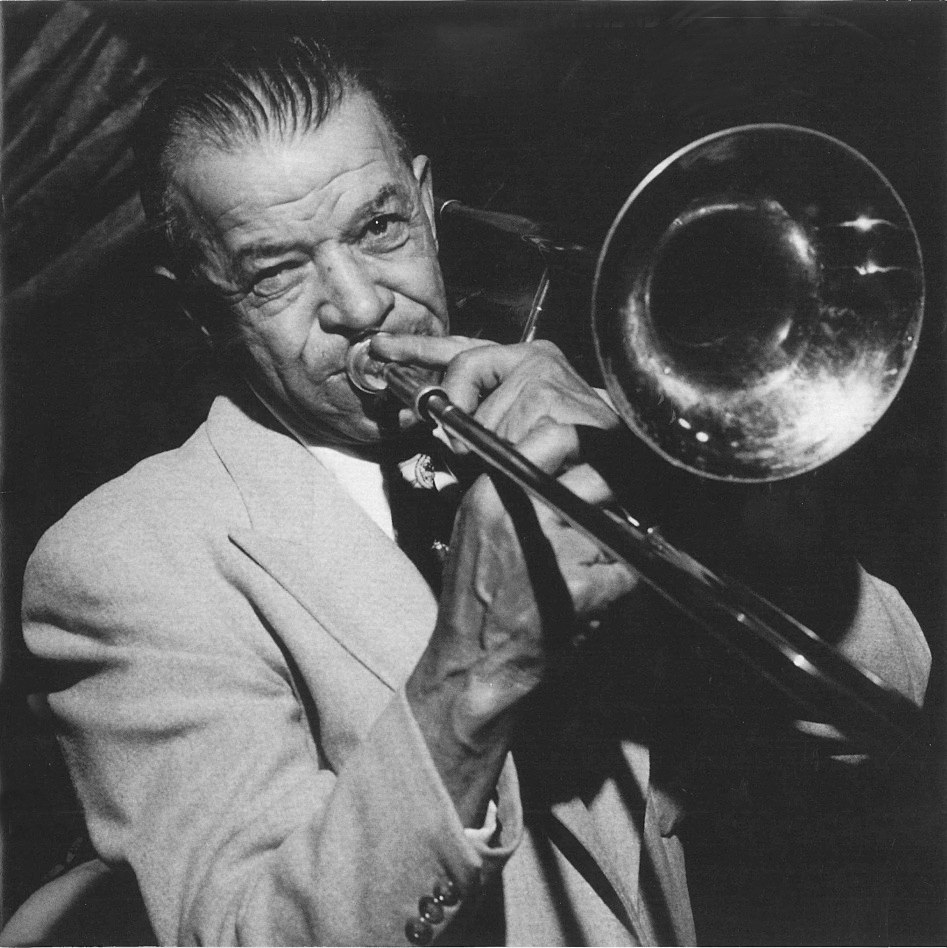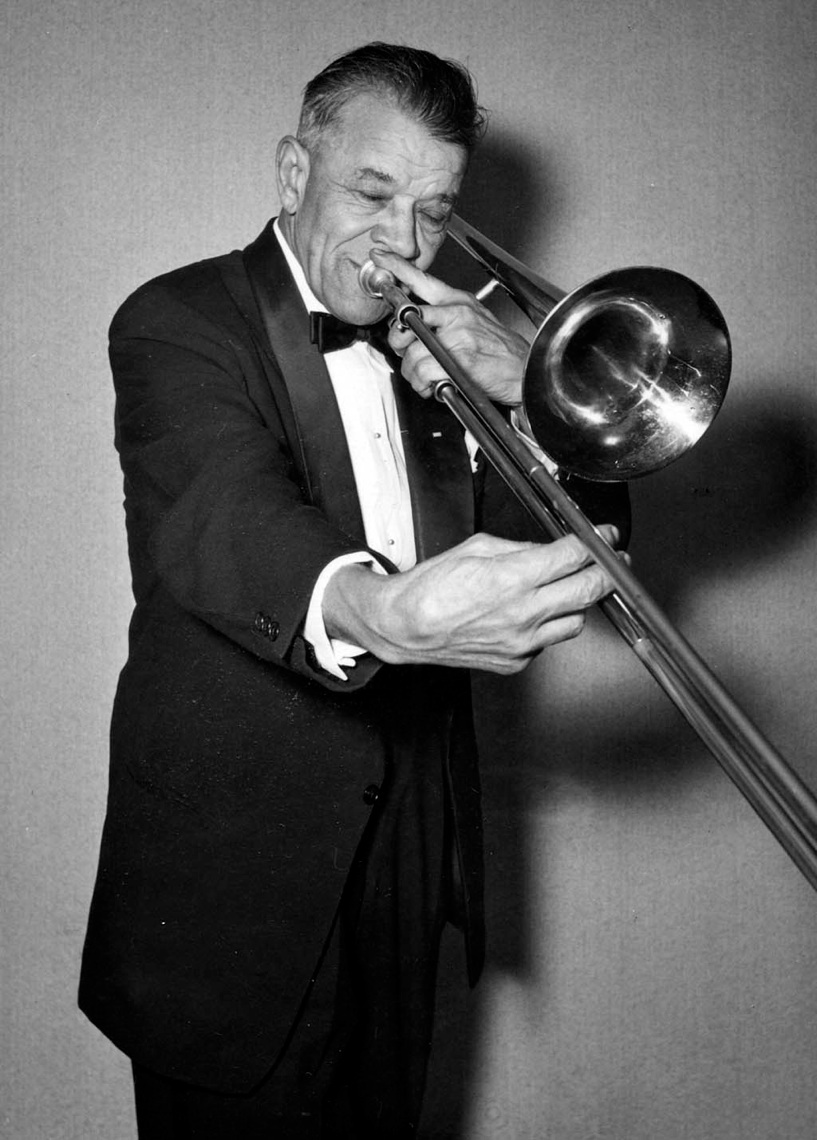KID ORY

Kid Ory (Edward Ory, La Place, de Luisiana, 25 de diciembre de 1886 - Honolulu, 23 de enero de 1973) fue un trombonista estadounidense de jazz tradicional.
Comenzó a tocar, con once años, en una string band, bandas callejeras que utilizaban instrumentos caseros pero, ya en 1911, formó su Brown Skinned Babies, que incluía a King Oliver (corneta) y a Johnny Dodds (clarinete). En 1913, la banda incluye a Papa Mutt Carey en la corneta. Cuando Oliver se va a Chicago, es sustituido por Louis Armstrong.
En 1919, Ory se instala en California, donde constituye un grupo que, en 1922 grabará su famoso Ory's creole trombone. En 1924 deja Los Ángeles y la banda (cuya dirección asume Mutt Carey), y se establece en Chicago, donde graba con Armstrong y Oliver, además de Jelly Roll Morton. Permanece entre Chicago y Nueva York hasta 1930, año en que regresa a California con Carey. En 1933 deja la música, para dedicarse a la agricultura, al cuidado de caballos y, más tarde, a trabajar en el ferrocarril.
En los años 40, con el revival del dixieland, vuelve a la escena, tocando el saxo alto, aunque Orson Welles le convence de volver al trombón. Durante la década de 1950, se convierte en una de las figuras más populares del Dixieland Jubilee, haciendo extensas giras por EE.UU. y Europa. Abre un club en San Francisco, en el que sigue tocando hasta 1961.
Por razones de salud, se retira a Hawái, en 1966, con apariciones ya muy esporádicas en Festivales de Jazz y films, hasta su muerte, en 1973.
Estilo
Kid Ory fue conocido como El Rey del Tailgate, que es precisamente un estilo trombonístico llevado a su máxima expresión por él, para cubrir sus limitadas capacidades técnicas para improvisar1 y que se caracterizaba por un lenguaje rudo y vehemente, de voz llena y opulenta, fraseo rápido y fluido, repleto de breves glisandos, que funciona como un perfecto sostén de la improvisación colectiva propia del hot.2
Biography
Ory started playing music with homemade instruments in his childhood, and by his teens was leading a well-regarded band in southeast Louisiana. He kept LaPlace, Louisiana, as his base of operations because of family obligations until his twenty-first birthday, when he moved his band to New Orleans. He was one of the most influential trombonists of early jazz.
Ory was a banjo player during his youth, and it is said that his ability to play the banjo helped him develop "tailgate", a particular style of playing the trombone with a rhythmic line underneath the trumpets and cornets.
When Ory was living on Jackson Avenue, he was discovered by Buddy Bolden, playing his first new trombone, instead of an old Civil War trombone. Ory's sister said he was too young to play with Bolden.
Ory had one of the best-known bands in New Orleans in the 1910s, hiring many of the great jazz musicians of the city, including the cornetists Joe "King" Oliver, Mutt Carey, and Louis Armstrong, who joined the band in 1919; and the clarinetists Johnny Dodds and Jimmie Noone.
In 1919, he moved to Los Angeles—one of a number of New Orleans musicians to do so near that time—and he recorded there in 1921 with a band that included Mutt Carey, the clarinetist and pianist Dink Johnson, and the string bassist Ed Garland. Garland and Carey were longtime associates who would still be playing with Ory during his 1940s comeback. While in Los Angeles, Ory and his band recorded two instrumentals, "Ory's Creole Trombone" and "Society Blues", as well as a number of songs. They were the first jazz recordings made on the West Coast by an African-American jazz band from New Orleans. His band recorded with Nordskog Records; Ory paid Nordskog for the pressings and then sold them with his own label, "Kid Ory's Sunshine Orchestra", at Spikes Brothers Music Store in Los Angeles.
In 1925, Ory moved to Chicago, where he was very active, working and recording with Louis Armstrong, Jelly Roll Morton, Oliver, Johnny Dodds, Bessie Smith, Ma Rainey, and many others. He mentored Benny Goodman and, later, Charles Mingus.
During the Great Depression Ory retired from music and did not play again until 1943. He ran a chicken farm in California. From 1944 to about 1961 he led one of the top New Orleans–style bands of the period. His sidemen during this period included, In addition to Carey and Garland, the trumpeters Alvin Alcorn and Teddy Buckner; the clarinetists Darnell Howard, Jimmie Noone, Albert Nicholas, Barney Bigard, and George Probert; the pianists Buster Wilson, Cedric Haywood, and Don Ewell; and the drummer Minor Hall. All but Buckner, Probert, and Ewell were originally from New Orleans.
The Ory band was an important force in reviving interest in New Orleans jazz, making popular 1940s radio broadcasts—among them a number of slots on The Orson Welles Almanac program (beginning March 15, 1944).In 1944–45 the group made a series of recordings for Crescent Records, which was founded by Nesuhi Ertegun for the express purpose of recording Ory's band.
During the late 1940s and early 1950s, Ory and his group appeared at the Beverly Cavern in Los Angeles. In 1958 he played at 'On the levee' on the waterfront at San Francisco. Ory retired from music in 1966 and spent his last years in Hawaii, with the assistance of Trummy Young. Ory died in Honolulu. He was buried at Holy Cross Cemetery, Culver City, California.





Comentaris
Publica un comentari a l'entrada